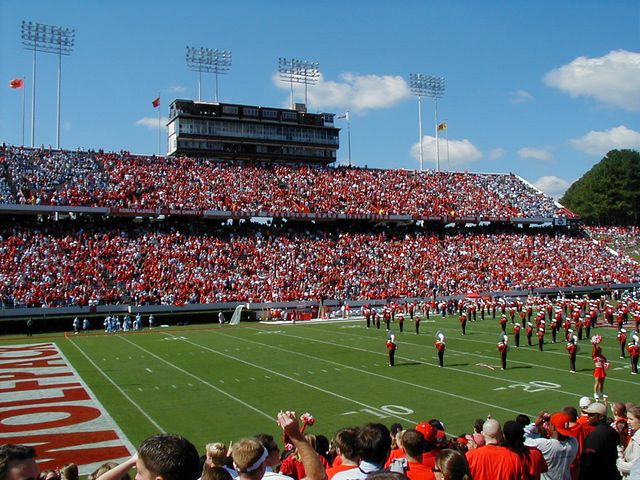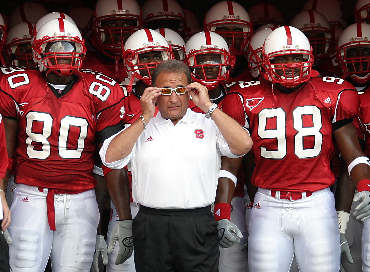This is Part II of a five-part series that is by no means intended to be authoritative. Rather, it’s nothing more than an incomplete, inconclusive, sometimes erroneous, while always biased retrospective of recent State football history. Part of this was based on nothing more than my attempt to answer the question so many of us are left asking year after year: How did we get here?

The only known picture from LRM's days in the student section, circa 2001
Part II: Chuck
 Chuck Amato arrived at State in early January 2000 already well-known to State fans; to some, from his days leading State’s White Shoes Defense in 1967, but to all of us, as the chief assistant under Bobby Bowden’s national powerhouse at Florida State — two national titles (1993 & 1999) and eight ACC titles (1992-99) — for 19 years. The titles mattered, but he was also a likeable guy whose unique style was in stark contrast to that of his predecessor’s. This desperate fan base was immediately inspired by him, if for no other reason than we wanted to believe in him. The importance of this cannot be understated, because the perception of promise alone was enough for the Wolfpack Club and athletic department to roll out its brilliantly-designed Lifetime Rights (more like Racket), the plan linked to season tickets that would ensure long-term financial commitments from the fans based on expected future value (I’m seven years into mine and still waiting).
Chuck Amato arrived at State in early January 2000 already well-known to State fans; to some, from his days leading State’s White Shoes Defense in 1967, but to all of us, as the chief assistant under Bobby Bowden’s national powerhouse at Florida State — two national titles (1993 & 1999) and eight ACC titles (1992-99) — for 19 years. The titles mattered, but he was also a likeable guy whose unique style was in stark contrast to that of his predecessor’s. This desperate fan base was immediately inspired by him, if for no other reason than we wanted to believe in him. The importance of this cannot be understated, because the perception of promise alone was enough for the Wolfpack Club and athletic department to roll out its brilliantly-designed Lifetime Rights (more like Racket), the plan linked to season tickets that would ensure long-term financial commitments from the fans based on expected future value (I’m seven years into mine and still waiting).
Amato got the immediate financial commitment from us and, more importantly, he got Philip Rivers. In his debut in 2000, Amato led State to a 4-0 start and our first victory over Carolina since 1992, then eventually led an overachieving team to an 8-4 record and a come-from-behind MicronPC Bowl victory over Minnesota. Then in 2001, he became the first ACC coach to win in Tallahassee since Florida State had joined the conference in 1992, and for the first time in a decade, State was going to a bowl in consecutive seasons (although we lost to Antonio Bryant and Pittsburgh 34-19 in the Tangerine Bowl the day after I graduated).
Through two seasons, most of us were pleased with the progress of a very young team, especially considering the magnitude of the recruiting inroads Amato had made in Florida — we were landing athletes that were capable of being playmakers at multiple positions. For the first time since 1994, many of us believed there was something brewing, evidenced by the influx of new LTRs and season ticket sales.
By October 2002, it appeared Amato had finally delivered on his seemingly far-fetched rhetoric. After a 38-6 ESPN Thursday-night romp at Clemson, we were 9-0 and ranked eighth by the AP. Driving back home up I-85 after the game late that night, my buddy Worm and I were talking Fiesta Bowl, or as a consolation, the Orange Bowl as ACC champions. But like so many times before (and since), those plans proved to be a bit premature. Amato, like so many before him (but hopefully not after him), was unable to escape that miscreant destiny that keeps us State fans disdainfully, tragically grounded.
The following weekend in Raleigh, on a “picturesque” North Carolina November evening, State was in control, leading Georgia Tech 17-9 with 13:02 to play. To that point, our defense had manhandled Tech, highlighted by two different defensive stands inside the three that forced the Yellow Jackets to settle for two field goals. Alas, as the sun slipped behind those tall North Carolina pines west of Carter-Finley (but not quite 25 miles west, where most pines grow), an autumn chill filled the air, and upon it Tech rallied for 15 unanswered and then stopped State on three different drives in the fourth quarter to preserve the 24-17 victory and subsequently defeat any notion we had of our first national championship. Consecutive losses at Maryland and Virginia followed, which quickly eliminated any hopes of our first ACC title since 1979. There would be no trip to Miami for the New Year.
However, we salvaged the best season of our long football history with a 17-7 home victory over Florida State in the season finale. Along with the well-documented propensity for State fans to travel en masse to bowl games, the merit of our 10 wins rightfully earned us a berth to the Gator Bowl. Few pundits gave 17th-ranked State much of a fighting chance over 12th-ranked Notre Dame that New Year’s Day 2003, but Thunder Dan led a physical State defense that knocked both quarterback Carlyle Holiday and tight end Gary Godsey out of the game in the first quarter, and then intercepted backup Pat Dillingham three times while holding the Irish to only 286 total yards. Meanwhile, Rivers and Jerricho Cotchery connected 10 times for 127 yards and a touchdown. Even after the disheartening November meltdown, 2002 had appeared to be the breakout season for both Amato and the program.
Rivers’ return for his senior season fueled our intense optimism and soaring expectations for 2003, which was set up to be epic: State had both a legitimate Heisman contender and the chance to showcase him on national television against the defending National Champions, which would also serve as the game that would catapult us officially into the national championship hunt. Instead, we stumbled early with consecutive losses in Winston-Salem and then in that nationally-televised matchup in Columbus, which ended any national championship aspirations by mid-September. Hopes for a conference championship quickly faded over the next few weeks after dispiriting losses in Atlanta and then in Tallahassee. A season-ending home loss to Maryland after blowing a two-touchdown lead in the fourth quarter left us at 7-5, which was only good enough for another Tangerine Bowl bid, where Rivers led us past a mismatched Kansas 56-26. Like O’Cain after 1994, Amato failed to capitalize on the promise of 2002 and build any sustained success.
In 2003, the weak defense had been largely to blame for the five losses, while in 2004, it would be quite the opposite. The plan to replace Rivers with Jay Davis – and then replace Davis with Marcus Stone a couple years later – had always seemed firm and promising on paper. But in reality, it went horribly, terribly awry.
In retrospect, 2004 was the season where most of us realized anyone would look good coaching Philip Rivers. It was a season that harked back upon the decade prior: we won a game we shouldn’t have won, when State’s #1-ranked defense overwhelmed Virginia Tech in Blacksburg, handing the Hokies their only conference loss in their Sugar Bowl season; and we lost both a game we shouldn’t have lost and lost to Carolina in the same game, after referee Jim Knight disapproved of linesman Rick Page’s call and took T.A. McLendon’s winning touchdown off the scoreboard (something that can only happen to State, and only in Chapel Hill), and then on the next play after the reversal, T.A. tried to go over the top but instead fumbled away the “victory.†State finished at 5-6, and for the first time under Amato, was left out of the bowl picture.
In 2005, State salvaged an otherwise bland and disappointing season by winning four of its last five games and then defeated South Florida 14-0 in a listless Meineke Car Care Bowl (if you don’t remember much about that game, it’s probably because you missed all of the scoring while you were standing in line with me at Will Call through the entire first quarter). Nevertheless, Amato’s seat was hot. He usually tried to say all the right things, but that same rhetoric that had initially endeared us to him had begun to fall on deaf ears. He was proving to be all hat and no cattle; he lacked substance and many of us grew increasingly tired of his shtick, especially those of us that required at least some accountability.
The irony: in 2002 many of us were worried that Amato would leave us to replace Bobby Bowden at Florida State, but by 2006, many of us were hoping that he would.
This much is undeniable: State fans are a tough crowd, and by the end, he certainly wasn’t helping his cause. He was only 3-3 against Carolina, and had lost two straight in the series going into 2006, a season that quickly deteriorated into an absolute catastrophe that rivaled State basketball’s 0-for-February in 2000. He was unable to overcome early season losses at home to Akron – after which he deferred blame by calling Akron’s admissions of partial qualifiers an unfair advantage – and then a week later in Hattiesburg to Southern Mississippi. The season finally, mercifully, ended at 3-9, after seven consecutive losses. As it turned out, Amato’s tenure ingloriously ended in 2006 the exact same way as his predecessor’s in 1999, with losses on the road to Carolina and East Carolina.
After nearly 15 years of the newfound emphasis on the football program, we finally had the unrivaled state-of-the art facilities we’d been told for years we needed to compete and aspire to national prominence. What we needed in 2007 was someone that could build an actual foundation, but more importantly, someone that could win in Raleigh without Philip Rivers.
That would be no small feat.



You must be logged in to post a comment.